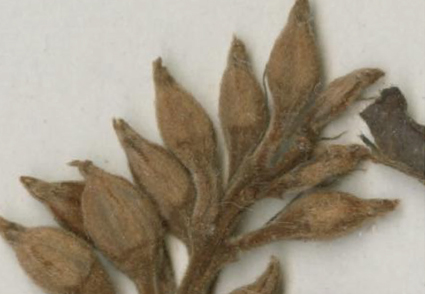Abstract
Based on examination of relevant literature and herbarium specimens, we designate a lectotype for Bauhinia esquirolii Gagnep., the basionym of Phanera esquirolii (Gagnep.) Sinou & Bruneau. We also synonymize P. comosa (Craib) Bandyop. & Ghoshal under P. esquirolii and provide an emended description of the latter.
References
- Bandyopadhyay, S. & Ghoshal, P.P. (2015) Seven new combinations in Phanera (Fabaceae: Caesalpinioideae: Cercideae). Telopea 18: 141–144. https://doi.org/10.7751/telopea8535
- Chen, T.C. (1988) Bauhinia. In: Chen, T.C. (Ed.) Flora Reipublicae Popularis Sinicae 39. Science Press, Beijing, pp. 145–203.
- Chen, T.C., Zhang, D.X., Larsen, K. & Larsen S.S. (2010) Bauhinia. In: Wu, Z.Y., Raven, P.H. & Hong, D.Y. (Eds.) Flora of China 10. Science Press, Beijing & Missouri Botanical Garden Press, St. Louis, pp. 6–21.
- Clark, R.P., Mackinder, B.A. & Banks, H. (2017) Cheniella gen. nov. (Leguminosae: Cercidoideae) from southern China, Indochina and Malesia. European Journal of Taxonomy 360: 1–37. https://doi.org/10.5852/ejt.2017.360
- Craib, W.G. (1913a) Bauhinia comosa. Bulletin of miscellaneous information 1913 (9): 352. https://doi.org/10.2307/4115030
- Craib, W.G. (1913b) Bauhinia henryi. Bulletin of miscellaneous information 1913 (9): 353.
- Craib, W.G. (1913c) Bauhinia saxatilis. Bulletin of miscellaneous information 1913 (9): 353–354.
- de Loureiro, J. (1790) Flora Cochinchinensis 1. Typis, et expensis academicis, Ulyssipone, 394 pp.
- de Wit, H.C. (1956) A revision of Malaysian Bauhinieae. Reinwardtia 3: 381–539.
- Franchet, A.R. (1896) Plantae Delavayanae. P. Klincksieck, Paris, 240 pp.
- Gagnepain, F. (1912) Bauhinia nouveaux d’extrême-orient. Notulae Systematicae 2 (6): 171.
- Gu, S.R., Zeng, Q.B., Clark, R., Jiang, K.W., Pérez-Escobar, O.A., Li, S.J., Tan, W.N., Xie, Z., Mattapha, S., Shi, M.M., Wang, X.P., Zhao, Z.T., Antonelli, A., Tu, T.Y., Wen, J. & Zhang, D.X. (2024) Phylogeny and re-circumscription of Cheniella (Leguminosae: Cercidoideae) based on plastome data and morphology, with description of three new species. Taxon 73 (2): 475–502. https://doi.org/10.1002/tax.13177
- Harms, H.A.T. (1921) Repertorium Specierum Novarum Regni Vegetabilis. Selbstverlag des Herausgebers, Berlin, 467 pp.
- Keng, Y.L. (1939) The gross morphology of Andropogoneae. Sinensia 10: 273–343.
- Korthals, P.W. (1841) Bauhinia. Verhandelingen over de natuurlijke geschiedenis der Nederlandsche overzeesche bezittingen, Botanie 2: 77–92.
- Larsen, K. & Larsen, S.S. (1984) Bauhinia. In: Smitinand, T. & Larsen, K. (Eds.) Flora of Thailand 4(1). The Forest Herbarium, Royal Forest Department, Bangkok, pp. 4–45.
- Larsen, K. & Larsen, S.S. (1996) Bauhinia. In: Kalkman, C., Stevens, P.F., Kirkup, D.W., de Wilde, W.J.J.O. & Nooteboom, H.P. (Eds.) Flora Malesiana 12 (2). Rijksherbarium & Hortus Botanicus, Leiden, pp. 442–535.
- Linnaeus, C. (1753) Species Plantarum 1. Impensis Laurentii Salvii, Holmiae, 560 pp.
- Schmitz, A. (1977) Nouvelle contribution à la taxonomie des Bauhinieae (Caesalpiniaceae). Belgische Botanische Vereniging 110 (1–2): 12–16.
- Sinou, C., Forest, F., Lewis, G.P. & Bruneau, A. (2009) The genus Bauhinia s.l. (Leguminosae): a phylogeny based on the plastid trnL-trnF region. Botany 87: 947–960. https://doi.org/10.1139/B09-065
- Sinou, C., Cardinal-McTeague, W. & Bruneau, A. (2020) Testing generic limits in Cercidoideae (Leguminosae): Insights from plastid and duplicated nuclear gene sequences. Taxon 69 (1): 67–86. https://doi.org/10.1002/tax.12207
- Trethowan, L., Clark, R.P. & Mackinder, B.A. (2015) A synopsis of the neotropical genus Schnella (Cercideae: Caesalpinioideae: Leguminosae) including 12 new combinations. Phytotaxa 204 (4): 237–252. https://doi.org/10.11646/phytotaxa.204.4.1
- Turland, N.J., Wiersema, J.H., Barrie, F.R., Greuter, W., Hawksworth, D.L., Herendeen, P.S., Knapp, S., Kusber, W.-H., Li, D.-Z., Marhold, K., May, T.W., McNeill, J., Monro, A.M., Prado, J., Price, M.J. & Smith, G.F. (2018) International Code of Nomenclature for algae, fungi, and plants (Shenzhen Code) adopted by the Nineteenth International Botanical Congress Shenzhen, China, July 2017. Regnum Vegetabile 159. Koeltz Botanical Books, Glashütten, 254 pp. https://doi.org/10.12705/Code.2018
- Mattapha, S., Suddee, S., Duangjai, S. & Kiewbang, W. (2022) Phanera mekongensis (Fabaceae: Cercidoideae), a new species from Thailand as supported by morphological and molecular evidence. Blumea 67 (2): 113–122. https://doi.org/10.3767/blumea.2022.67.02.04
- Miquel, F.A.W. (1855) Papilionaceae. In: Deel, E. (Ed.) Flora van Nederlandsch Indië. C. G. van der Post, Amsterdam, pp. 55–348. https://doi.org/10.5962/bhl.title.93
- Wang, Y.H., Wicke, S., Wang, H., Jin, J.J., Chen, S.Y., Zhang, S.D., Li, D.Z. & Yi, T.S. (2018) Plastid genome evolution in the early diverging legume subfamily Cercidoideae (Fabaceae). Frontiers in Plant Science 9: 138. https://doi.org/10.3389/fpls.2018.00138
- Wunderlin, R.P. (2010a) Reorganization of the Cercideae (Fabaceae: Caesalpinioideae). Phytoneuron 48: 1–5.
- Wunderlin, R.P. (2010b) New combinations in Schnella (Fabaceae: Caesalpinioideae: Cercideae). Phytoneuron 49: 1–5.
- Wunderlin, R.P., Larsen, K. & Larsen, S.S. (1981) Cercideae. In: Polhill, R.M. & Raven, P.H. (Eds.) Advances in legume systematics 1. Royal Botanic Gardens, Kew, pp. 107–116.
- Wunderlin, R.P., Larsen, K. & Larsen, S.S. (1987) Reorganization of the Cercideae (Fabaceae: Caesalpinioideae). Biologiske Skrifter, DetKongelige Danske Videnskabernes Selskab 28: 1–40.
- Zhang, D.X. (1995) A cladistic analysis of Bauhinia (Leguminosae). Chinese Journal of Botany 7: 52–64.


